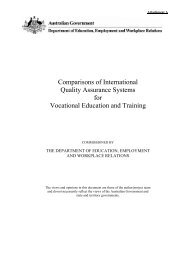Epidemics in a Changing World - Department of Innovation, Industry ...
Epidemics in a Changing World - Department of Innovation, Industry ...
Epidemics in a Changing World - Department of Innovation, Industry ...
Create successful ePaper yourself
Turn your PDF publications into a flip-book with our unique Google optimized e-Paper software.
How do they spread?<br />
Infectious agents are spread directly by contact or by droplets ejected when cough<strong>in</strong>g or<br />
sneez<strong>in</strong>g. Such close contact is a feature <strong>of</strong> the spread <strong>of</strong> respiratory viruses, for example,<br />
and hence the stress on hand wash<strong>in</strong>g and wear<strong>in</strong>g <strong>of</strong> masks to reduce the transmission <strong>of</strong><br />
<strong>in</strong>fluenza virus.<br />
EpidemICs <strong>in</strong> a Chang<strong>in</strong>g <strong>World</strong><br />
Report <strong>of</strong> the Expert Work<strong>in</strong>g Group<br />
6<br />
Indirect transmission can occur when the <strong>in</strong>fectious agent contam<strong>in</strong>ates an <strong>in</strong>animate<br />
object (e.g. droplets sneezed onto a door handle can be transferred to the next person to<br />
open that door). Similarly, contam<strong>in</strong>ated food, water or blood products can be vehicles for<br />
<strong>in</strong>fectious agents.<br />
Mosquitoes and midges are examples <strong>of</strong> <strong>in</strong>sects that act as carriers, or vectors, <strong>of</strong> <strong>in</strong>fectious<br />
agents. Their role <strong>in</strong> disease emergence was seen <strong>in</strong> Fiji <strong>in</strong> 1979 when local mosquitoes<br />
acquired Ross River virus from <strong>in</strong>fected Australian tourists and transmitted it to the local<br />
population. This resulted <strong>in</strong> the largest such outbreak ever recorded, with some 500,000<br />
<strong>in</strong>fections and 50,000 symptomatic cases. The epidemic ran for a year before subsid<strong>in</strong>g. A<br />
further example is provided by the current situation <strong>in</strong> north Queensland; dengue-<strong>in</strong>fected<br />
travellers from Indonesia, Papua New Gu<strong>in</strong>ea and/or Vanuatu were bitten by local mosquitoes,<br />
trigger<strong>in</strong>g outbreaks.<br />
Long-range airborne dispersal is another <strong>in</strong>direct means <strong>of</strong> transmission. Aerosols conta<strong>in</strong><strong>in</strong>g<br />
the <strong>in</strong>fectious agent are dispersed <strong>in</strong> very f<strong>in</strong>e sprays that rema<strong>in</strong> airborne over long distances<br />
and can then <strong>in</strong>fect via <strong>in</strong>halation. This mechanism was responsible for many <strong>of</strong> the outbreaks<br />
<strong>of</strong> Q fever that have occurred <strong>in</strong> Australia.<br />
Sources <strong>of</strong> emerg<strong>in</strong>g <strong>in</strong>fectious disease risk for Australia<br />
The pr<strong>in</strong>cipal risks <strong>of</strong> epidemic disease to Australia derive from three sources. The first is the<br />
potential entry <strong>of</strong> disease through our northern borders. Fruit bats and birds regularly cross<br />
from Indonesia and Papua New Gu<strong>in</strong>ea to Australia, especially across the Torres Strait and the<br />
Timor Sea, potentially <strong>in</strong>troduc<strong>in</strong>g new viruses <strong>in</strong>to Australia. Fruit bats, for example, can carry<br />
henipaviruses (Hendra and Nipah).<br />
The second risk area is entry through our sea ports and airports. For example, new <strong>in</strong>fluenza<br />
viruses will almost certa<strong>in</strong>ly be carried to Australia by a passenger on a plane, and dengue<br />
virus is brought <strong>in</strong>to Australia annually by <strong>in</strong>fected travellers com<strong>in</strong>g through airports. (The<br />
mosquito Aedes aegypti that carries dengue is widespread <strong>in</strong> Queensland and facilitates<br />
human to human transmission.) S<strong>in</strong>ce November 2008, north Queensland has experienced<br />
a prolonged outbreak <strong>of</strong> dengue (the worst for 50 years), with over 1000 cases to date. The<br />
2007 outbreak <strong>of</strong> equ<strong>in</strong>e <strong>in</strong>fluenza occurred as a result <strong>of</strong> the entry <strong>of</strong> an <strong>in</strong>fected horse <strong>in</strong>to<br />
Australia and the subsequent escape <strong>of</strong> the virus from a quarant<strong>in</strong>e station.<br />
The third area <strong>of</strong> risk is diseases that emerge <strong>in</strong> Australia, especially from livestock and<br />
wildlife. Some 60% <strong>of</strong> recent (1940–2004) new and emerg<strong>in</strong>g diseases have their orig<strong>in</strong>s <strong>in</strong><br />
animals. It is these diseases <strong>in</strong> particular that will cont<strong>in</strong>ue to surprise and challenge us. For<br />
example, it took several years to <strong>in</strong>vestigate and determ<strong>in</strong>e that the cause <strong>of</strong> Tasmanian devil<br />
facial tumour disease was a transmissable tumour. We do not have good processes <strong>in</strong> place to<br />
<strong>in</strong>vestigate and prioritise diseases <strong>of</strong> wildlife.
















